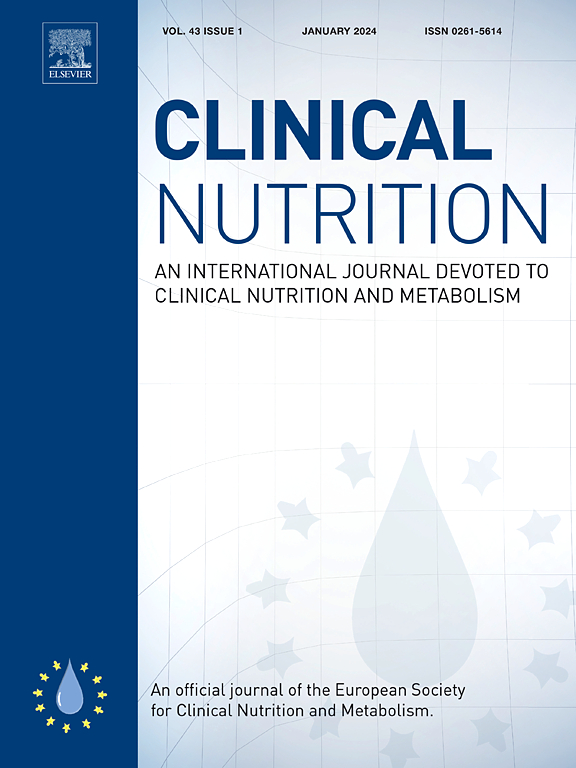心血管手术患者节段性细胞外水与全身水比对预后的影响
IF 7.4
2区 医学
Q1 NUTRITION & DIETETICS
引用次数: 0
摘要
背景和目的术中液体管理是心血管手术患者护理的关键组成部分。细胞外水分与全身水分之比(ECW/TBW)已被认为是围手术期评估的有价值的生物标志物,因为它整合了有关液体潴留、肌肉萎缩和营养状况的信息。然而,关于ECW/TBW的临床应用及其与心血管手术术后长期预后的关系的证据仍然有限。本研究旨在探讨ECW/TBW对心血管手术患者长期死亡率的预后价值。方法本回顾性队列研究纳入2016年10月至2021年3月在日本名古屋心脏中心接受选择性心血管手术的连续患者。术前使用生物电阻抗分析评估ECW/TBW,并测量全身和四肢各节段的ECW/TBW。使用Kaplan-Meier和多变量Cox回归分析评估ECW/TBW与出院后全因死亡率之间的关系。使用受试者工作特征曲线计算各节段ECW/TBW的全因死亡率临界值。结果共纳入859例患者,平均年龄68.4±11.9岁,男性占67.6%。全身ECW/TBW与log NT-proBNP呈显著正相关(ρ = 0.51, p <;0.001)和年龄(ρ = 0.58, p <;0.001),与骨骼肌质量指数呈负相关(ρ = - 0.33, p <;0.001),体重指数(ρ = - 0.22, p <;0.001),峰值握力(ρ = - 0.60, p <;0.001),膝关节伸展等长肌力(ρ = - 0.51, p <;0.001),老年营养风险指数(ρ = - 0.51, p <;0.001)。平均随访时间为907.6±500.8 d,死亡46例(5.4%)。基于ECW/TBW的Kaplan-Meier生存曲线显示,ECW/TBW越高,预后越差(log-rank检验,p <;0.001)。Cox回归分析显示,即使在调整了多个混杂因素后,ECW/TBW与死亡风险之间仍存在独立关联。由受试者工作特征曲线得出的全因死亡率临界值为:全身ECW/TBW为0.396(曲线下面积[AUC], 0.768),上肢ECW/TBW为0.390 (AUC, 0.764),下肢ECW/TBW为0.398 (AUC, 0.764)。结论节段性ECW/TBW是预测心血管手术患者长期死亡率的有效指标。虽然ECW/TBW与肌肉质量和身体功能密切相关,但这种相关性在较高的ECW/TBW水平上减弱,从而影响测量精度。因此,结合这些措施可以实现更准确的术后风险分层。本文章由计算机程序翻译,如有差异,请以英文原文为准。
Prognostic impact of segmental extracellular water to total body water ratio in cardiovascular surgery patients
Background and aims
Perioperative fluid management is a key component of care for patients undergoing cardiovascular surgery. The ratio of extracellular water to total body water (ECW/TBW) has been recognized as a valuable biomarker for perioperative assessment, as it integrates information regarding fluid retention, muscle wasting, and nutritional status. However, evidence regarding the clinical utility of ECW/TBW and its association with long-term postoperative outcomes in cardiovascular surgery remains limited. This study aimed to investigate the prognostic value of ECW/TBW for long-term mortality in patients undergoing cardiovascular surgery.
Methods
This retrospective cohort study included consecutive patients who underwent elective cardiovascular surgery between October 2016 and March 2021 at Nagoya Heart Center, Japan. ECW/TBW was assessed using bioelectrical impedance analysis before surgery and measured for the whole body, as well as each segment of the extremities. The association between ECW/TBW and all-cause mortality after discharge was assessed using Kaplan–Meier and multivariate Cox regression analyses. The cut-off value for all-cause mortality at each segmental ECW/TBW was calculated using the receiver operating characteristic curve.
Results
In total, 859 patients were included in this study (mean age = 68.4 ± 11.9 years, 67.6 % male). Whole-body ECW/TBW showed a significant positive correlation with log NT-proBNP (ρ = 0.51, p < 0.001) and age (ρ = 0.58, p < 0.001) and negative correlation with skeletal muscle mass index (ρ = −0.33, p < 0.001), body mass index (ρ = −0.22, p < 0.001), peak grip strength (ρ = −0.60, p < 0.001), knee extension isometric muscle strength (ρ = −0.51, p < 0.001), and Geriatric Nutritional Risk Index (ρ = −0.51, p < 0.001). The mean follow-up period was 907.6 ± 500.8 days, during which 46 patients (5.4 %) died. Kaplan–Meier survival curves based on ECW/TBW tertiles showed that higher ECW/TBW was associated with worse prognosis (log-rank test, p < 0.001). Cox regression analysis showed an independent association between ECW/TBW and mortality risk, even after adjusting for multiple confounding factors. The cut-off values for all-cause mortality, derived from the receiver operating characteristic curve, were 0.396 (area under the curve [AUC], 0.768) for whole-body ECW/TBW, 0.390 (AUC, 0.764) for upper-extremity ECW/TBW, and 0.398 (AUC, 0.764) for lower-extremity ECW/TBW.
Conclusions
The segmental ECW/TBW is a useful predictor of long-term mortality in patients undergoing cardiovascular surgery. Although ECW/TBW strongly correlates with muscle mass and physical function, this correlation weakens at higher ECW/TBW levels, affecting measurement accuracy. Therefore, combining these measures may achieve more accurate postoperative risk stratification.
求助全文
通过发布文献求助,成功后即可免费获取论文全文。
去求助
来源期刊

Clinical nutrition
医学-营养学
CiteScore
14.10
自引率
6.30%
发文量
356
审稿时长
28 days
期刊介绍:
Clinical Nutrition, the official journal of ESPEN, The European Society for Clinical Nutrition and Metabolism, is an international journal providing essential scientific information on nutritional and metabolic care and the relationship between nutrition and disease both in the setting of basic science and clinical practice. Published bi-monthly, each issue combines original articles and reviews providing an invaluable reference for any specialist concerned with these fields.
 求助内容:
求助内容: 应助结果提醒方式:
应助结果提醒方式:


